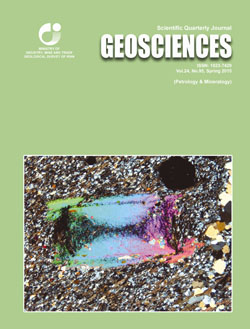Document Type : Original Research Paper
Authors
1 Assistant Professor, Department of Geology, Islamic Azad University, Islamshahr Branch, Tehran, Iran
2 Assistant Professor, Department of Geology, Faculty of Basic Sciences, Islamic Azad University,North, Tehran Branch, Tehran, Iran
3 M.Sc., Department of Geology, Faculty of Basic Sciences, Islamic Azad University, North Tehran Branch, Tehran, Iran
Abstract
The outcropped intrusive bodies in NW of Takestan show a combination of granite, granodiorite, tonalite, monzodiorite, quartz syenite, quartz monzodiorite, monzonite, quartz monzonite, and diorite. The granitoids rocks are calc-alkaline, high-K calc-alkaline, shoshonite, and metaluminous in character. The shoshonite characteristics of these rocks are caused by deformations created by the effect of penetration of hydrothermal solutions, which also increased some of the mobile elements such as potassium. The tectonic environment of these granitoid bodies are determined based on the geochemistry of main elements as collision (of Late Orogenic) and post collision uplift as well as collision (IAG+CAG+CCG) and based on the geochemistry of REE as volcanic arc granitoids, and collision granitoids (VAG+SYN+COLG) specially post collision granitoids. The chondrite normalized spider diagram of granitoid rocks of NW Takestan including samples having intermediate to acidic compositions, are enriched by LREE such as La, Ce, Pr to HREE such as Tm, Yb, Lu. Negative anomaly of Eu shows not only governing of the restoration of the terms in magma, but also display the entrance of the double capacity of this element in feldspar structure especially plagioclase. The normalized pattern of these granitoids with ORG shows their enrichment of LILE specially K, Rb, and Ba against HFSE (Nb & Zr) and HREE such as Y, Yb. This pattern is similar to the granitoid patterns, which are formed by the volcanic arc granitoids (VAG).
Keywords

